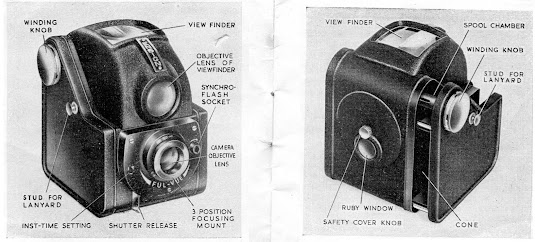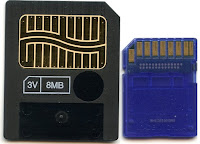Last month’s post about photographic lenses and extension tubes set me thinking about the cameras I’ve used over the years. Some were also in the loft.
1950s
The Ensign took most of our family photographs until 1962 when I received a Kodak Brownie Starmite camera for Christmas and became the family photographer. This used smaller 127-sized frames (40mm square), also 12 per roll. Pictures from both the Ensign and the Starmite have appeared many times on this blog, especially indoor flash.
1974
After starting work I wanted a 35mm single-lens reflex colour slide camera. One of the most economical to buy was the Russian Zenith E. It cost £33 from York Camera Centre in January, 1973.
Comparing the quality of the Zenith images with the Ensign and Starmite negatives, you can see why it was cheap. I would have been better with something slightly more expensive, perhaps Pentax or Praktica, but the Zenith was fairly robust and I used it into the nineteen-nineties. It survived hours in rucksacks including two weeks backpacking in Iceland, and once rolled several hundred feet down a mountainside in Switzerland. Unfortunately, the fabric shutter is now torn beyond repair. As the lenses have gone to the charity shop, the camera body might as well go for metal recycling.

One nice touch was that the Zenith came with a free book, “Discover Rewarding Photography: the Manual of Russian Equipment”, which, despite its name, contained helpful hints and useful information.
1994
2001
The software for transferring images from the memory cards was awkward. You couldn’t just stick it into a computer slot like now because the ‘Camedia’ cards were enormous – seen here beside a standard SD card for comparison. I bought additional 16MB cards to take more photographs. A hundred was luxury after 35mm film. The camera was also a little heavy because it used four AA batteries. It still works but is worth at most £20 on ebay. Should it go to the electrical equipment recycling skip?
With two young children the Olympus was used a lot, but after a few years I noticed that the images had a small number of blank pixels. It seemed time to upgrade.
2006
Technology was advancing rapidly and getting cheaper too. My 7.1 megapixels Canon Digital Ixus 70 cost £169.99 in April 2006, and I still use it today. It has a similar spec. to the Olympus: a 3x optical zoom (35-105mm), a macro function and built in flash, but also an extensive range of image settings and unlimited movie time with sound. Mine is set to 3072 x 2304 pixels at 180 dots per inch which creates jpg images of 3.5MB. Even a ‘small’ 4GB SD card stores loads.
You can get much higher spec. cameras now, even on phones, but this is fine for most purposes. However, one might say that it isn’t as much fun, and doesn’t have the same mystique as the Zenith.
Not wanting to disappoint the technical amongst us, here are links to the Ensign Ful-Vue, Zenith E and Pentax Espio instruction booklets and manual.









When you bought your first digital camera, a friend told me 2 megapixels would give great results and you will never need more than that. Who knows what my current camera is but it does do 40X optical zoom. My phone works just as well except for really long shot photos and weighs much less.
ReplyDeleteThe 2.1 MP camera was OK and I have the pictures still on my computer. But digital cameras very soon had a lot more settings making them more adjustable, as well as higher resolution. I suspect most of the "advances" became available in those first few years.
DeleteSmart phone cameras have really done away with cameras! I remember seeing all these old models though.
ReplyDeleteMy mobile phone does calls and texts only.
DeleteCameras are like a foreign language to me. Sorry!
ReplyDeleteThere is a lot to be said for simple ones where you "point and click".
DeleteOur family camera was a brownie box, 120 film, six exposures, little red window telling you the frame number. My brother won it in the thirties in an essay contest. Photos were rare treasures!
ReplyDeleteSix exposures sounds very limited - I didn't know you could get films shorter than 12. People take an enormous number of photographs these days, in comparison.
DeleteWe used to get 8 exposure ones. 12 was a treat. Well, mum bought them and she was in charge.
Delete6, 8 or 12, you tried to make every one count.
DeleteI once walked into Argos and bought a digital camera and asked the girl on the checkout if it needed a film?🤔
ReplyDeleteI'm sure she was doing her best.
DeleteOur family camera started out as a Brownie Box in the 1950s. By the 1970s, and with many cameras in between, my father got into photography in a big way with a couple of Hasselblads with so many attachments he fitted out a suitcase with special foam insets for all the items. Weighed 35 lbs. I know because I hauled that case all over the UK for him on one memorable trip. Weighed more than my third son who was one year old at the time. Had to haul him, too, in a stroller, up and down all the steps (and over bridges) found in railway stations. Needless to say, I was more fit then. :)
ReplyDeleteMy mother didn't find out how much all that camera equipment cost until after my dad died. Good thing, or she might have been tempted to do him in earlier.
Mary
Goodness me. Hasselblads - that's serious equipment. And you have to be seriously interested in photography to take that amount of equipment around with you. I'm too much of a dabbler ever to spend that much on just one interest (except maybe musical instruments).
DeleteI well remember the Zenith E camera as the go-to model at the bottom end of the SLR price range I have rather dropped out from much photography, just using a smartphone, but I miss the flexibility of trading aperture and shutter speed to vary depth of focus on a smartphone.
ReplyDeleteI was always more interested in the meaning of the images and the events they represented rather than photographic quality. It is satisfying to get an aesthetically good image, but I've never been what you lmght call a serious photographer.
DeleteO the joy of dropping off the reel of film and waiting to collect it. Today with all the iPhone's etc it's just not the same is it?
ReplyDeleteBriony
x
Yes, I used to like the rigmarole of having films developed and printed. Sometimes the pictures that came back would be from months before.
DeleteI don't think I'd be happy with 3X zoom, my first digital camera had 5X I think or maybe more, I don't remember what the Sony had. My Fuji has 30X zoom and the Canon that I now use most has 50X. The Fuji and Canon are bigger cameras though, they don't fit in my jacket pockets like the early cameras did.
ReplyDeleteI tend to find it difficult to avoid camera-shake on long zoom, even when the camera is supported. I doubt I'd ever need 30x or 50x.
DeleteMy Fuji is 16 megapixels and the Canon is 20.3 megapixels
ReplyDeleteYou certainly can see the detail at those levels of resolution.
DeleteF Dad had a 'posh' camera for its time, and a light meter in a little leather case thay opened on both sides. There used to be lots of messing with f-stops and shutter speeds. All the family photos were taken on that - posed, shutter on a timer so he could join the arrangement. F is a point a click (phone these days) photographer. Do you think group photos look more relaxed and informal than they used to in days of processed film?
ReplyDeleteThey could look very staged. I used to like the shutter-delay setting so I could take a picture and have time to rush round and be in it.
Delete